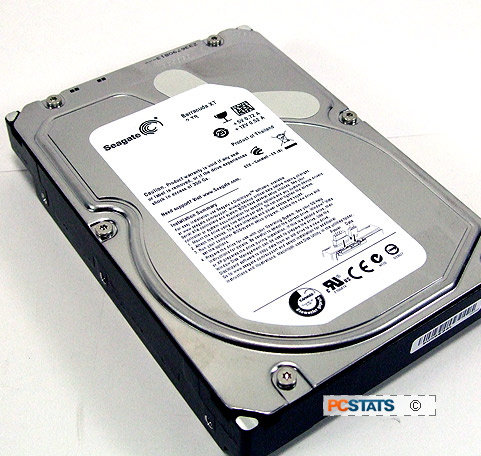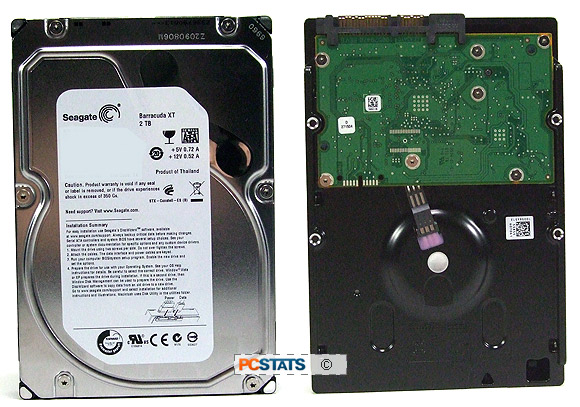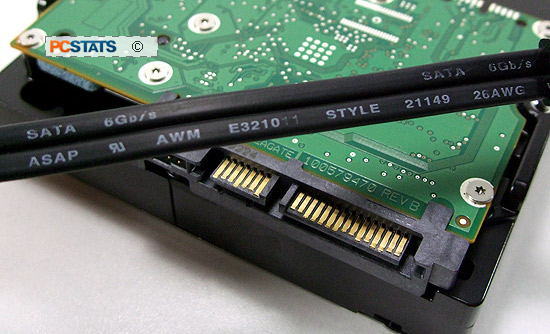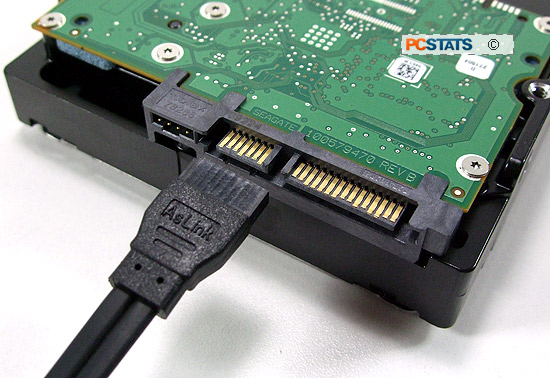In this review PCSTATS will be testing out Seagate's
2TB, 6Gb/s SATA III Barracuda XT hard drive. This 3.5" desktop hard drive features
an increased 64MB onboard cache where other 2TB drives only
have 32MB and it supports Native Command Queing (NCQ). The Barracuda XT is the
performance oriented drive in Seagate's stables, a spindle speed of
7200RPM gives it a healthy maximum sustained data rate of 138MB/s.
The Barracuda family also includes 'Green' drives which
are intended to reduce hard drive power consumption - the obvious side benefits
being cool running and reduced noise levels. Vanilla Barracuda drives shore
up Seagate's mainstream offerings, these drives have slightly less cache
than the Barracuda XT family. Barracuda XT drive capacities range from 2TB to
3TB and offer a fantastic 5 year limited warranty.
The Seagate Barracuda XT being reviewed today
uses Perpendicular Magnetic Recording technology and has a capacity of 2
TeraBytes (2,000 GB). Beneath its shiny metal exterior are four platters
rotating at 7,200RPM. Each platter has an aerial density of 374GB/in2, so
this 3.5" SATA III HDD should come close to attaining is listed sustained
transfer rate of 138MB/s in PCSTATS' benchmark set.
Seagate's 2 TB Barracuda XT (ST32000641AS) SATA III hard drive retails for about $249 CDN ($249 USD, £140 GBP) at stores like Newegg.com.
 |
|
Seagate Barracuda XT
2TB Hard Drive |
|
 |
|
|
|
Model: Seagate
ST32000641AS
Type : Hard Disk Drive
|
|
Capacity: 2.0TB (7200RPM,
five-platters)
Interface: 6Gb/s SATA III /
NCQ
Standard Drive Cache:
64MB
MSRP Price: $249 USD
| |
| |
Peak transfer rate for this SATAIII drive is
600MB/s, while average latency is listed at a quick 4.16ms. The drive is
backwards compatible with SATA I and SATA II interfaces. Power is
supplied by a SATA style power connector, only. The 2TB Barracuda XT drive
wasn't too loud by our standards, idling at 2.7 bels and generating 2.9 bels
when seeking. Average operational power consumption is a modest 9.2W.

6Gb/s SATA III Expectations and Requirements
Hard drives rated to 6Gb/s SATA III interface speeds communicate with a
PC faster, but at the outset the speed bump is going to be muted and in
real world terms it is not twice as fast as a 3Gb/s drives. Put
it this way; Serial ATA I operates at 1.5Gb/s, Serial ATA II operates at 3Gb/s
and Serial ATA III runs at 6Gb/s. You'd be hard pressed to saturate a SATA II
connection with 3Gb/s burst of data for anything more than a fleeting moment and
that's why SATA III, while a faster interface
, realistically has a small impact in bandwidth intensive situations.
Mechanical hard drives just aren't fast enough to saturate a 6Gb/s bandwidth
connection continuously, but moving forward new technologies and Solid State
Drives (SSD) likely will.

It's considered good form to use SATA
6Gb/s rated cables with SATA III hard drives. The reason is that some
cheap SATA cables bundled with motherboards may be fine at SATA II
levels, but can be subject to electrical
interference that hampers SATA III speeds due to lack of cable shielding, poor
quality materials, etc.
This does not mean there are any differences
in terms of electrical connections between SATA III / SATA II / SATA
cables, there are not. Suffice to say,
not all SATA cables are created equally, but at least SATA 6Gb/s rated cables
should be of sufficient tolerance.

To take advantage of the Barracuda XT's 6Gb/s SATA III
interface, your computer will need SATA III complaint ports, either via the
motherboard chipset or a hardware controller such as the Marvell 88SE9123. If this part of the
chain is absent, the drive is backwards compatible with SATA 3Gb/s and SATA
1.5Gb/s interface levels.
Alrighty, let's power up this 2TB SATA III hard drive up and test it!
Test System Specs:
The
details of how the 2 TB Seagate Barracuda XT
(model: ST32000641AS) hard drive test system were configured for benchmarking,
including the specific hardware, software drivers, operating system and
benchmark versions are indicated below. In the second column are the general
specs for the reference platforms this SATA III hard drive is to be compared
against. Please take a moment to look over PCSTATS test system configurations
before moving on to the individual benchmark results.
 |
| PCSTATS Test System Specs |
|
test system |
| processor:
|
intel Core i7 920
(45nm) |
| Clock
Speed: |
20 x 133 MHz=2.67 GHz |
| Socket: |
Socket LGA1366 |
| Motherboard: |
- Intel X58
-
Gigabyte G1.Assassin |
| Videocard: |
ASUS ENGTS250
DK
(Geforce GTS250) |
| Memory: |
3x 2GB Corsair TR3X6G1600C8D DDR3 |
| Memory
Speed: |
DDR3-1333 |
| Storage: |
- HDD
3TB Seagate 3TB Barracuda XT
(6GB/s SATA III)
2TB Seagate 2TB Barracuda XT (6GB/s SATA
III)
1TB Western Digital 1TB WD1001FALS (3GB/s SATA II)
74GB Western Digital
Raptor WD740 (3GB/s SATA II)
- SSD
120GB OCZ Vertex2
(3GB/s SATA II)
Plextor PX-128M1S (3GB/s SATA II)
-
SSHD
500GB
Seagate Momentus XT SSHD (3GB/s SATA II)
750GB
Seagate Momentus XT SSHD (6GB/s SATA III)
|
| Optical
Drive: |
Plextor PX-B310U
Blu-Ray |
| Power
Supply: |
Seasonic SS-760KM
(760W) |
| Heatsink: |
Intel Reference LGA1366 Heatsink |
| Monitor
(1080p): |
ASUS MK241
24" HD LCD |
| Software
Setup: |
Microsoft Windows 7 Ultimate
Intel INF
9.2.0.1025
nVIDIA Forceware
266.58 | |

